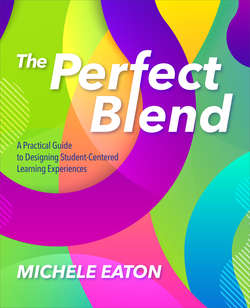Читать книгу The Perfect Blend - Michele Eaton - Страница 41
На сайте Литреса книга снята с продажи.
Path
ОглавлениеIncorporating online learning into your daily classroom routine can also facilitate individualized learning in a more manageable way by giving students some agency over the path of their learning. When some of the instruction happens online, students can make decisions about how they learn the material and what assessments they complete.
The path of learning can be individualized for students even without giving them the agency over those decisions. Adaptive software and programs can be wonderful tools for providing digital content that meets students exactly where they are and moves them to the next step in their learning in a competency-based fashion. Many of these programs are labeled as “personalized,” but teachers should be wary. Tools like these can be incredibly powerful additions to the classroom, but I urge you to consider where students get to demonstrate agency in a blended environment heavily reliant on adaptive software. Although adaptive software can provide highly individualized instruction, if not used intentionally, it can suppress the very agency it professes to encourage. If students have no control over the path of their learning, it is teacher- or computer-driven and not student-centered.
Although personalized paths throughout a lesson can be accomplished without technology, a blended learning environment has the potential to make the process of personalizing learning paths more manageable, freeing you to focus on using data received from students’ self-directed learning to create individualized and differentiated learning experiences for students.
PLEASANT VIEW ELEMENTARY
Fifth-grade teachers at Pleasant View Elementary in Providence, Rhode Island, for example, facilitate personalized and blended learning in their classrooms by leveraging student agency over path (The Learning Accelerator, n.d.). Students in these classrooms begin each unit with a pre-assessment. This pre-assessment helps the students identify their levels of proficiency over the learning objectives. Students then take this information to make decisions about playlists, resources, and supports they need to be successful and reach mastery. Because this is a big responsibility for elementary students, the teachers scaffold support for students, gradually releasing the responsibility to the students. For more information about Pleasant View’s approach to personalized learning, visit bit.ly/PVESpath.
Online instruction within a blended classroom gives a teacher the tools they need to do what technology cannot. In Chapter 4, we will do a deep dive into specific strategies and tools to help students gain more autonomy over the path of their learning.
